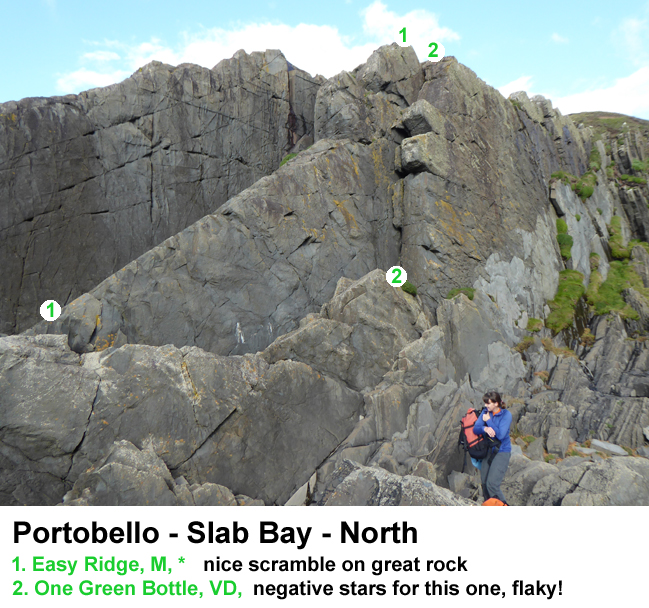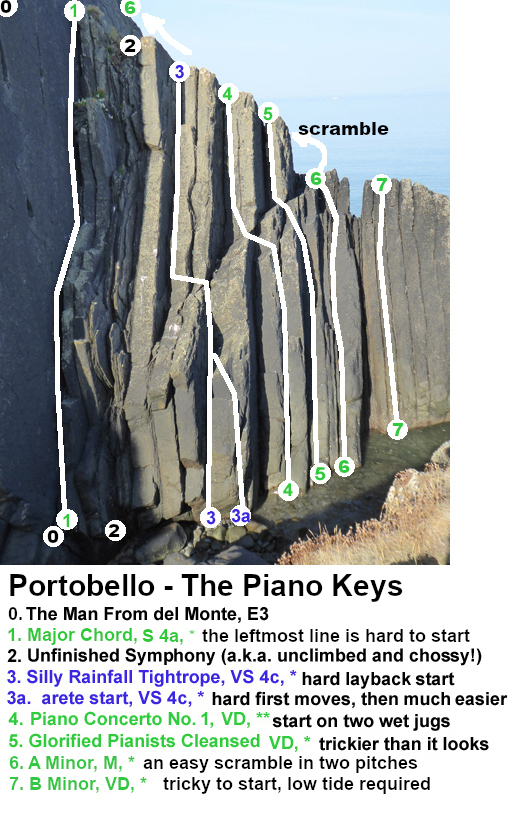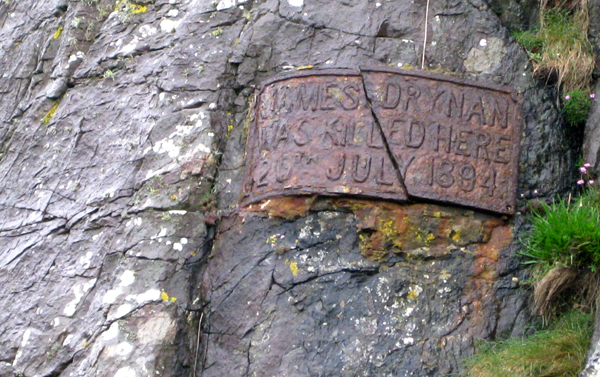
Introduction Portobello is a climbing area NW of Stranraer, on the coast of the North Channel. The climbing quality is a bit mixed. There are areas of poor quality rock that are "intimidating" to lead on and also some good quality greywacke. However it's a very nice area in general, there are never any midges, and there are a lot of good routes as well!. It makes a pleasant venue for a day trip or a bit of cragging combined with a barbecue or picnic. There is a short approach down a farm track, lots of lush grass and at low tide there is a nice beach to relax or play on.
Access Many of the routes are affected by the tide, indeed some of them are only half as long at high tide....so coming at low tide is recommended. However one or two areas, such as Primrose Inlet and Cracked Block Bay have good climbing above the tide line. To get here follow the A77 or A75 to Stranraer then the A718, B7043 and finally the B738 to Cairnbrook Farm. A private track, which used to be signposted "To The Crags", leads down past a small ruined house, to a second ruin with limited parking. The main beach is just 5 minutes walk down the lane to the sea. Portobello Bay Cliff is immediately north of this beach. Some of the other areas described here are about 300m south of this beach, and it may be quicker to reach these from the parking area by cutting diagonally over the field opposite to a gate on the skyline.
Guidebook For a definitive list of all the climbs and boulder problems at Portobello see the SMC published Lowland Outcrops guidebook. Included on this page are details of most of the routes I have done.
Dangers This is a greywacke sea cliff with several areas of dubious rock, lots of fragile flaky holds and for the same reason the protection is not always reliable. Routes following wide cracks are the most reliable, followed by narrow cracks and then open face/slabby routes. It's definitely sound advice to place more protection than usual (if you can!) to guard against a fragile hold snapping and /or a fragile runner placement bursting. Some of the routes are tidal and require low tide and/or calm seas to be climbable. This is a very open stretch of coast so much of the crag will be hazardous in big seas.
From north to south the main climbing areas are:-
Primrose Inlet
Slab Bay
& The Piano Keys
Axle Bay
Portobello Bay Cliff
Shark Fin Bay
The U-Boat Pen
Cracked Block Bay

Andy and Helen climbing Horse Latitudes, E1 5a, Sea Buttress, Portobello.
Primrose Inlet
A nice, small, south facing area, somewhat overlooked by the SMC guidebook. Primrose Inlet is not affected by seabirds and not affected much by the tide either. Primrose Inlet lies about 300m north of the main cliff. From the parking area, follow the wall out towards the sea north of the beach, cross over or through the gate, walk around the top of the first (dry) inlet (Slab Bay) then immediately head diagonally down towards the sea to this narrow inlet. It is easily missed if you are walking northwards and is also not as far north as marked in the guidebook. Descent to the bottom of the routes is straightforward.


Lex leading Bottom Feeders, HVS 5a, a fine short route at Primrose Inlet.
Slab Bay

On the south side of the bay is a feature called the Piano Keys... the name was chosen after the What Three Words location reference for the first route climbed, "glorified.pianists.cleansed" ...and the resemblance of the rock to some piano keys in good lighting. These are all interesting and slightly deceptive routes on pretty solid rock with good protection. They are 15-20m long. The line on the left - marked as 2 below - was not climbed due to the large number of chossy sharp flakes in the groove. First ascents were made in July 2021 and June 2023 by John and Linda Biggar.
Low or mid-tide is necessary for a dry start, especially at the right-hand end. Most of the routes finish up the easy second "pitch" of the moderate scramble "A Minor". Watch out for the three or four loose blocks in the groove on the third steepening of Major Chord. They are not needed for the climb in any way... so best not touched at all!

Axle Bay

Portobello Bay Cliff
This area is generally free of seabirds all year.

Out to seaward from Limpet Buttress is the 12-15m high Sea Buttress, which has some very good climbing. There are committing abseil approaches to small ledges or even hanging belays. The climbing on Sea Buttress is generally extremely good, but there are a lot of thin, fragile flakes so take great care if leading. As they are fully tidal anyway, most of the climbs can still be done at high tide, but big waves would be a problem. The best protected and most straightforward routes here are Happy Man and Puffin Nuffin. The top of Happy Man is easily located by looking for the left hand end (looking out) of the big grassy ledge just 1-1½m below the top of the buttress.


Memorial to James Drynan at the foot of Crawfords Crackers on Limpet Buttress.
Shark Fin Bay
About 300m south of the beach this bay is readily distinguished by the Sharks Fin Pinnacle in the sea. The climbing here is a bit scrappy, though Mussel Bound is worth doing. This area can be badly affected by seabirds in the spring. You may get dive-bombed. The rest of the summer you could end up with guano covered hands, gear and rope...nice. Access is complicated. It is possible to descend to the base of the crag about 100m south (steep grass), and to reach the top of the crag from about 100m north (mostly very easy rock scrambling). The former will not be possible for a couple of hours around high tide. Thee issues make it much more convenient to set up an abseil if you are doing multiple routes here, best done down Basking up the Wrong Tree. The scramble from the top of the promontory to the summit, graded Diff and suggested as an escape route in the guidebook, is not recommended!

The U-boat Pen
The U-boat pen lies immediately south of Shark Fin Bay. This area can also be affected by seabirds in the spring, but the rock remains fairly clean of guano. There are normally no nests on the routes themselves. Very low tide, or scuba gear is essential for many of these routes, especially those on the left (see the topo..!). Descent is by easy scrambling round the back. These routes are about 10-12m high. The top half of Feeling the Pinch has particularly good climbing.

Cracked Block Bay
Cracked Block Bay is immediately south of the U-boat Pen. It is easily distinguished by the striking Cracked Block of Thunderbolt. NOTE: There was a BIG rockfall here in about 2019, it may not be safe to climb for a while!
Quickest access to this area is to cut diagonally over the corner of a field from the ruined house parking area to a gate on the horizon. Then turn leftish to reach the Cracked Block area. Descent to the base of all these routes is straightforward. In general there are no seabirds in this area.
On the north side of the chunky block that is seaward from Thunderbolt there are a number of Diff and V. Diff routes. These appear to be hard to get to at all but the lowest of tides, and furthermore are hard to descend from other than by abseil or downclimbing... they make for interesting expeditions at the grade!

The striking line taken by Thunderbolt, HVS 5a. This route may need to be re-graded following a recent rockfall.

Descent from this cliff is by abseil. There is a large block on the summit.
Just south of the main wall in Cracked Block bay is a small 10m wall. This area is not affected by the sea or seabirds and you can walk easily off the back of these routes. The routes are a bit dirty, although Parallel Lines itself is worthwhile.

In the next bay south there is an unclimbed pinnacle... probably for a very good reason!!
March Port
The last crag at Portobello is March Bay, located just beyond the boundary wall and nearly 500m south of the beach. The climbs here appear a bit scrappy. I've not done them yet but here is a photo of the crag.






